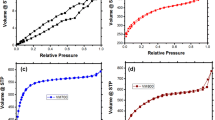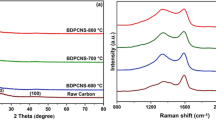Abstract
The porous carbons with high specific surface area and excellent electrochemical properties were prepared using three types of green needle coke as raw materials. Electrochemical performances of the porous carbons derived from different microstructure green needle coke were investigated. The XRD and Raman spectra demonstrated that the content of the ordered carbon microcrystals were decreased and the content of amorphous and cross-linked structure were increased in the porous carbons with comparison to the raw materials. The results of N2 adsorption–desorption analysis verified that the content of ordered microcrystalline structure in the raw materials evidently influence the specific surface area and pore size distribution of the porous carbons. The porous carbon with 1665 m2 g−1 specific surface area and 2.89 nm average pore size has shown that the specific capacitance was 288 F g−1 at the current density 1 A g−1. Furthermore, the capacity retention was 94.93% and the Coulombic efficiency was 92.87% after 5000 charge/discharge cycles.







Similar content being viewed by others
References
Wang DH, Wang YZ, Chen Y, Wei L, Wang HQ, Zhao PH, Li Y, Zhang JF, Dong YG, Hu SL, Yang JL (2018) Coal tar pitch derived N-doped porous carbon nanosheets by the in-situ formed g-C3N4 as a template for supercapacitor electrodes. Electrochim Acta 283:132–140
Lee JW, Lee HI, Park SJ (2018) Facile synthesis of petroleum-based activated carbons/tubular polypyrrole composites with enhanced electrochemical performance as supercapacitor electrode materials. Electrochim Acta 263:447–453
Rohit RC, Jenifer A, Jagadale AD, Kumbhar VS, Lee H, Lee K (2020) Facile synthesis of Ce-doped α-cobalt hydroxide nanoflakes battery type electrode with an enhanced capacitive contribution for asymmetric supercapacitors. J Energy Storage 28:101277
Chen L, Chen X, Wen Y, Wang B, Wu YC, Sheng ZT, Wu C (2020) Nitrogen-enriched reduced graphene oxide for high performance supercapacitor electrode. J Nanosci Nanotechnol 20:4854–4859
Ciszewski M, Koszorek A, Radko T, Szatkowski P, Janas D (2019) Review of the selected carbon-based materials for symmetric supercapacitor application. J Electro Mater 48:717–744
Scalia A, Varzi A, Lamberti A, Tresso E, Jeong S, Jacob T, Passerini S (2018) High energy and high voltage integrated photo-electrochemical double layer capacitor. Sustain Energ Fuels 2:968–977
Senokos E, Reguero V, Palma J, Vilatela J, Marcilla R (2016) Macroscopic fibres of CNTs as electrodes for multifunctional electric double layer capacitors: from quantum capacitance to device performance. Nanoscale 8:3620–3628
Jing K, Bo Z, Yang H, Yang J, Shuai X, Yan J, Cen K (2017) Temperature dependence of ion diffusion coefficients in NaCl electrolyte confined within graphene nanochannels. Phys Chem Chem Phys 19:7678–7688
Ou DW, Liu JQ, Yan J, Qin QQ, Xu J, Wu YC (2020) Construction of three-dimensional graphene like carbon on carbon fibers and loading of polyaniline for high performance asymmetric supercapacitor. Electrochim Acta 335:1–10
Xia KS (2008) Hierarchical porous carbons with controlled micropores and mesopores for supercapacitor electrode materials. Carbon 46:1718–1726
Chang YC, Sohn HJ, Ku CH, Wang YG, Korai Y, Mochida I (2016) Anodic performances of mesocarbon microbeads (MCMB) prepared from synthetic naphthalene isotropic pitch. Carbon 37:1285–1297
Gryglewicz G, Machnikowski J, Lorenc-Grabowska LG, Frackowiak E (2005) Effect of pore size distribution of coal-based activated carbons on double layer capacitance. Electrochim Acta 50:1197–1206
Morita M, Arizono R, Yoshimoto N, Egashira M (2014) On the electrochemical activation of alkali-treated soft carbon for advanced electrochemical capacitors. J Appl Electrochem 44:447–453
Lee GJ, Pyun SI (2006) Effect of microcrystallite structures on electrochemical characteristics of mesoporous carbon electrodes for electric double-layer capacitors. Electrochim Acta 51:3029–3038
Gopalakrishnan A, Kong CY, Badhulika S (2019) Scalable large-area synthesis of heteroatom-doped few-layer graphene-like microporous carbon nanosheets from biomass for high-capacitance supercapacitors. New J Chem 43:1186–1194
Nakamura M, Nakanishi M, Yamamoto K (1996) Influence of physical properties of activated carbons on characteristics of electric double-layer capacitors. J Power Sources 60:225–231
Choi PR, Kim SG, Jung JC, Kim MS (2017) High-energy-density activated carbon electrode for organic electric-double-layer-capacitor using carbonized petroleum pitch. Carbon Lett 22:70–80
Mochida I, Maeda K, Takeshita K (1977) Structure of anisotropic spheres obtained in the course of needle coke formation. Carbon 15:17–23
Zhao D, Zhao HQ, Ye JQ, Wei S, Miao SY, Shen HT, Zhao Y, Kang MM, Li Z (2020) Oxygen functionalization boosted sodium adsorption-intercalation in coal based needle coke. Electrochim Acta 329:1–8
Zhong Y, Xu L, Li C, Zhang B, Wu WJ (2019) Needle coke: a predominant carbon black alternative for printable triple mesoscopic perovskite solar cells. Carbon 153:602–608
Qiao WM, Yoon SH, Mochida I (2006) KOH activation of needle coke to develop activated carbons for high-performance EDLC. Energy Fuel 20:1680–1684
Yang S, Kima IJ, Jeona MJ, Kima K, Moona SI, Kima HS, An KH (2008) Preparation of graphite oxide and its electrochemical performance for electric double layer capacitor. J Ind Eng Chem 14:365–370
Wang JZ, Wang LQ, Chen MM, Wang CY, Zheng C (2015) Nanoporous carbons from oxidized green needle coke for use in high performance supercapacitors. New Carbon Mater 30:141–149
Sun X, He JP, Tang J, Wang T, Guo YX, Xue HR, Ma Y (2012) Structural and electrochemical characterization of ordered mesoporous carbon-reduced graphene oxide nanocomposites. J Mater Chem 22:10900–10910
Zhao CJ, Ge ZX, Zhou YA, Huang YF, Wang GF, Qian XZ (2017) Solar-assisting pyrolytically reclaimed carbon fiber and their hybrids of MnO2/RCF for supercapacitor electrodes. Carbon 114:230–241
Yang MH, Hong SB, Choi BG (2015) Hierarchical MnO2 nanosheet arrays on carbon fiber for high-performance pseudocapacitors. J Electroanal Chem 759:95–100
Zhang YJ, Chen HL, Wang SJ, Zhao X, Kong FG (2020) Regulatory pore structure of biomass-based carbon for supercapacitor applications. Microporous Mesoporous Mater 297:110032
Zhai D, Li B, Kang F, Dua H, Xu C (2010) Preparation of mesophase-pitch-based activated carbons for electric double layer capacitors with high energy density. Microporous Mesoporous Mater 130:224–228
Sonibare OO, Haeger T, Foley SF (2010) Structural characterization of Nigerian coals by X-ray diffraction, Raman and FTIR spectroscopy. Energy 35:5347–5353
Manoj B, Kunjomana AG (2012) Study of stacking structure of amorphous carbon by X-ray diffraction technique. Int J Electrochem Sci 7:3127–3134
Kim JD, Roh JS, Kim MS (2017) Effect of carbonization temperature on crystalline structure and properties of isotropic pitch-based carbon fiber. Carbon Lett 21:51–60
Huang Y, Wei Q, Wang Y, Dai L (2018) Quantitative study of the microcrystal structure on coal based on needle coke with curve-fitted of XRD and Raman spectrum. Carbon 136:150–159
Yan JC, Lei ZP, Li ZK, Wang ZC, Ren SB, Kang SG, Wang XL, Shui HF (2020) Molecular structure characterization of low-medium rank coals via XRD, solid state 13 C NMR and FTIR spectroscopy. Fuel 268:117038
Yang CJ (2013) Preparation of activated carbon from coke powder by KOH activation. Adv Mater Res 616:1894–1897
Chen K, Zhang H, Ibrahim UK, Xue WY, Liu H, Guo A (2019) The quantitative assessment of coke morphology based on the Raman spectroscopic characterization of serial petroleum cokes. Fuel 246:60–68
Liu D, Gao J, Wu S, Qin Y (2016) XRD and Raman characterization of microstructure changes of char during pyrolysis. J Harbin Inst Technol 48:39–45
Morga R, Jelonek I, Kruszewska K (2014) Relationship between coking coal quality and its micro-Raman spectral characteristics. Int J Coal Geol 134:17–23
Sethia G, Sayari A (2016) Activated carbon with optimum pore size distribution for hydrogen storage. Carbon 99:289–294
Zhao X, Huang S, Cao J, Xi S, Wei X, Kamamoto J, Takarada T (2014) KOH activation of a Hypercoal to develop activated carbons for electric double-layer capacitors. J Anal Appl Pyrolysis 105:116–121
Tao Y, Kong D, Zhang C, Lv W, Wang M, Li B (2014) Monolithic carbons with spheroidal and hierarchical pores produced by the linkage of functionalized graphene sheets. Carbon 69:169–177
Xiao R, Xu S, Li Q, Su YM (2012) The effects of hydrogen on KOH activation of petroleum coke. J Anal Appl Pyrolysis 96:120–125
Zhang X, Wang X, Su J, Wang X, Jiang L, Wu H (2012) The effects of surfactant template concentration on the supercapacitive behaviors of hierarchically porous carbons. J Power Sources 199:402–408
Xing W, Qiao SZ, Ding RG, LiF LuGQ, Yan ZF, Cheng HM (2006) Superior electric double layer capacitors using ordered mesoporous carbons. Carbon 44:216–224
Li B, Wang G, Zhai D, Du H, Kang F (2011) The effect of the microstructure of mesophase-pitch-based activated carbons on their electrochemical performance for electric double layer capacitors. New Carbon Mater 26:192–196
Yang Q, Pang SK, Yung KC (2016) Electrochemically reduced graphene oxide/carbon nanotubes composites as binder-free supercapacitor electrodes. J Power Sources 31:144–152
Chen J, Sheng K, Luo P, Li C, Shi G (2012) Graphene hydrogels deposited in nickel foams for high-rate electrochemical capacitors. Adv Mater 24:4569–4573
Lee GJ, Pyun SI, Kim CH (2004) Kinetics of double-layer charging/discharging of the activated carbon fiber cloth electrode: effects of pore length distribution and solution resistance. J Solid State Electrochem 8:110–117
Acknowledgements
This work was supported by the Natural Science Foundation of China (U1361126), the Liaoning Provincial Education Department Project (2017LNQN04), the Youth Fund (2016QN25, 2017QN06) and the Open Fund (USTLKFSY201701) of the University of Science and Technology Liaoning, and the National Undergraduate Innovation Training Program (201710146000147).
Author information
Authors and Affiliations
Corresponding authors
Additional information
Publisher's Note
Springer Nature remains neutral with regard to jurisdictional claims in published maps and institutional affiliations.
Rights and permissions
About this article
Cite this article
Cheng, J., Lu, Z., Zhao, X. et al. Electrochemical performance of porous carbons derived from needle coke with different textures for supercapacitor electrode materials. Carbon Lett. 31, 57–65 (2021). https://doi.org/10.1007/s42823-020-00149-7
Received:
Revised:
Accepted:
Published:
Issue Date:
DOI: https://doi.org/10.1007/s42823-020-00149-7




